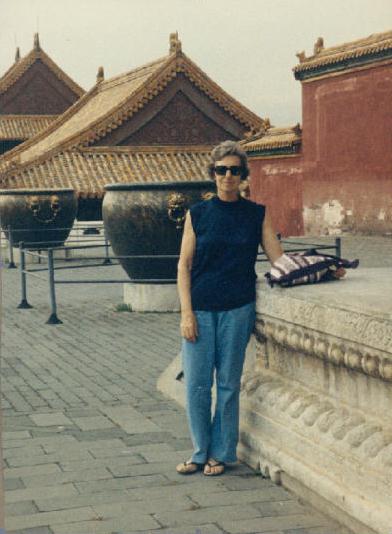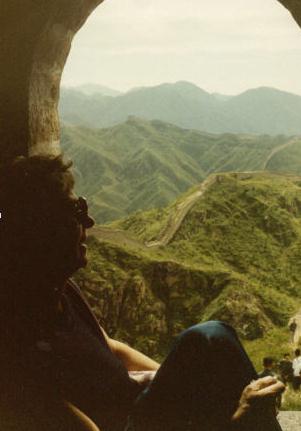
20 Summer Days In China by Betty Blunden (1974)

Today it was the Great Wall and the Ming tombs. A full day outing. My diary says: “Set off in a large and a mini bus. A two hour drive. The last half hour is up a valley, a clear stream flowing down the centre, occasional clusters of houses and patches of cultivation. Very rough country with boulders and stones on the mountain sides. I see the Tree of Heaven growing wild everywhere in its natural home. Our destination is the Palating section where there is an important pass in the Wall. There is a huge gateway in the Wall and a very large parking area. Hundreds of locals, PLA men with their families, a truck load of sailors. I see a PLA man holding his baby and giving it a bottle, standing in the middle of the parking area.
“This section of the Wall was rebuilt during the Ming Dynasty, 500 years ago. The original old Wall was built 600 BC was 6,000 KM long 6.6 metres high, 6.5 metres wide at the base, 5.5 metres wide at the top. The Wall was built not on a border but along the top of a mountain ridge. It was constructed of stone and mud. The Wall rebuilt during the Ming Dynasty was constructed with huge blocks of granite, bricks and mortar. There are two sections right and left of the pass each about a mile long and kept in perfect condition for tourists.”
We all started off ]by walking along the section on the right. There were fairly level sections, some steep ramps and some incredibly steep steps. It was tough walking. A hand rail had been added to the inside of the battlements to help the tourists along the steepest sections. 1 certainly needed the help. At intervals there were sentry boxes with stone arches looking out over this wild, wild country.
There were thousands of tourists walking along the wall. Mostly Chinese people, but there were visitors we recognized as guests from our hotel. We saw a couple of monks in their saffron robes, a very old Chinese lady being helped by two young people.
I walked as far as the end of this right hand renovated section. The wall from then on was in various states of ruin and a notice warned “Visitors not permitted”. From this point pieces of wall could be seen snaking in all directions over the ridges. It went on and on and on. The whole project was more than the mind could grasp. And it was dreamed up in 600BC !
We returned to the pass for lunch. Again the wonderful VIP treatment. We eat in a pavllion at long wooden tables. Every member of the group had a lunch box waiting. From my diary “Buttered bread, two boiled eggs, four kinds of cold meat, twist of paper with salt, two tooth picks, an apple. Fizz and beer for all. I eat less than half my lunch”.
our buses had driven through the great archway to turn and now we climbed into them again. Next stop, the Ming Tombs. Driving down the valley again I saw quite a few wild flowers on the mountain side. it must look quite incredible in spring. We also passed a section of the second smaller Wall that stood inside the Great Wall.
The tombs are in a great natural amphitheatre surrounded by hills. The approach is along an avenue made memorable by a series of carved sandstone animals that seem to stand guard. Camels and elephants, standing and crouching. They are 500 years old, looked to me to be of primitive design and very charming. Young willow trees are now planted between them and thick plantations of deciduous trees behind.
The underground tomb that we visited was Ting Ling, the tomb of the emperor Wan Li who ruled from 1537 to 1620. He started the construction of his tomb when he was 22 years old and it took eight years to build. We were told that the position of this tomb had been discovered by accident. When the tombs were built the last workers who finally sealed the tomb were put to death so the secret of the location of the tomb was to be kept for ever.
In 1958 a farmer ploughing the field uncovered what seemed to be part of a brick wall. He reported the find to the Archeological Department, and excavations were begun. We walked down a wide ramp that finally took us underground, then we descended by stairs built around a square shaft. The distance we went down seemed to me to be the equivalent of about five storeys in a modern building.

The tomb was of five chambers set out in the shape of a cross. The ceiling were very high and vaulted, a half circle without beams or columns. The construction was of large, perfectly tooled blocks of stone, absolutely austere and quite unlike anything we'd seen. It was also very cold. We had been warned to bring a warm cardigan and 1 needed mine.
There were three large carved marble thrones, very wide thrones. One each for two empresses who had predeceased the emperor and one for the emperor. There were also three very big coffins. On the walls big charts had been hung by the authorities to show graphically what this tomb had cost the people of China when it had been built. Materials had been brought from all over China, workers had been brought from all over China and there were never less than 35,000 workers involved during the eight years of construction. There was a diorama showing the miserable life led by the peasants at that time. One section of the tomb was an exhibition hall and funerary objects were displayed. These objects were the simplest and by far the most beautiful things I had seen in China. The design was utterly severe, quite unlike the objects on display in the Summer Palace and the Forbidden City. I remember a gold platter and a silver teapot that to me were perfect.
It was good to come out again into the warm sun. We gathered together under some ancient conifers some of which were propped up with thick poles. I cannot remember seeing really old trees anywhere else except in the Forbidden City and The Summer Palace. There were cold soft drinks waiting for us to drink before we returned to Peking. This drive, some of it in the dark was memorable for me. 1 had Young Mr. Wong sitting behind me in the bus and he sang all the way back to Peking. He sang quietly, mostly folk songs, and he sang beautifully.
There had been a battle of wills going on between the interpreters and the group. We had been quite overwhelmed by what they had done for us and wanted to take them out to dinner in a restaurant. We wanted to have them as our guests just for once. They did not like this idea at all. We were their guests in China and could not possibly take them out. We countered that by saying that it was an Australian custom for a visitor to accept an invitation from someone who had been entertaining them a great deal. Things were at a deadlock but we felt we had to win. And as it was now our second last day in Peking the outing had to be on the following night.
Then that night, while we were having dinner, Mr. Piao and Miss Chi came into the dining room radiating success. We had never seen them looking so pleased with themselves. They told Marje that the director of the Headquarters of the China Travel Service invited us to a banquet at the Peking Duck Restaurant the following night. They were of course delighted with the invitation. But we would produce a surprise for the occasion. We would have a scroll made and present it on the night. The wording was worked out. “May the bonds of friendship between the Chinese and Australian people continue to strengthen. From the Australia-China Society Tourist Group. August/September 1974.”